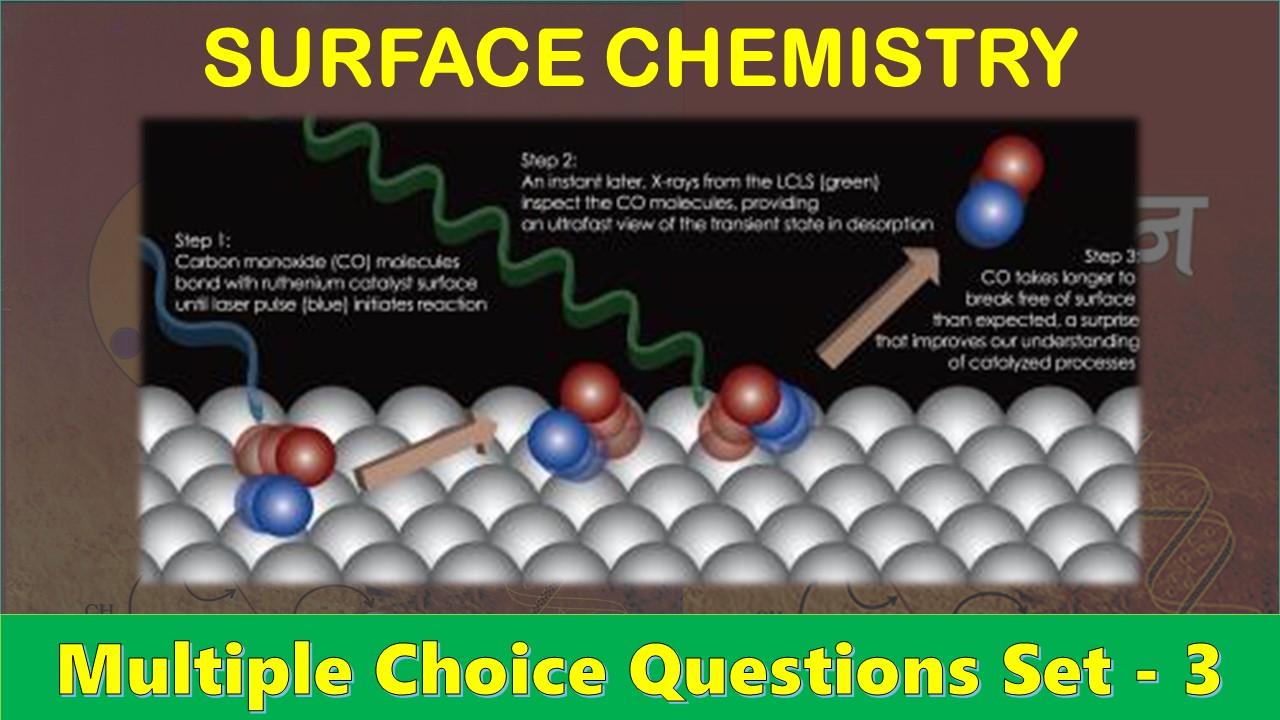CBSE Class 12 Surface Chemistry Multiple Choice Questions with Answers. MCQ Questions Class 12 Surface Chemistry with Answers Is Prepared Based on Latest Exam Pattern. Students can solve NCERT Class 12 Surface Chemistry MCQs with Answers to know their preparation level.
Students who are searching for NCERT MCQ Questions for Class 12 Surface Chemistry with Answers are compiled here to get good practice on all fundamentals. Know your preparation level on MCQ Questions for Class 12 Surface Chemistry with Answers. You can also verify your answers from our provided MCQ Class 12 Surface Chemistry with Answers. So, ace up your preparation with MCQ of Class 12 Chemistry Examinations.
MCQ Questions Class 12 Surface Chemistry with Answers - Set - 3
Question 1:
Position of non-polar and polar part in micelle
(a) polar at outer surface but non-polar at inner surface
(b) polar at inner surface non-polar at outer surface
(c) distributed over all the surface
(d) are present in the surface only.
Correct Answer – (A)
Question 2 :
The protecting power of lyophilic colloidal sol is expressed in terms of
(a) coagulation value
(b) gold number
(c) critical micelle concentration
(d) oxidation number.
Correct Answer – (B)
Question 3 :
Fog is a colloidal solution of
(a) solid in gas
(b) gas in gas
(c) liquid in gas
(d) gas in liquid.
Correct Answer – (C)
Question 4 :
On which of the following properties does the coagulating power of an ion depend?
(a) The magnitude of the charge on the ion alone
(b) Size of the ion alone
(c) Both magnitude and sign of the charge on the ion
(d) The sign of charge on the ion alone
Correct Answer – (C)
Question 5 :
Measuring zeta potential is useful in determining which property of colloidal solution?
(a) Viscosity
(b) Solubility
(c) Stability of the colloidal particles
(d) Size of the colloidal particles
Correct Answer – (C)
MCQ Questions Class 12 Surface Chemistry with Answers
Question 6:
Which one of the following forms micelles in aqueous solution above certain concentration?
(a) Dodecyl trimethyl ammonium chloride
(b) Glucose
(c) Urea
(d) Pyridinium chloride
Correct Answer – (A)
Question 7:
Which property of colloidal solution is independent of charge on the colloidal particles?
(a) Electroosmosis
(b) Tyndall effect
(c) Coagulation
(d) Electrophoresis
Correct Answer – (B)
Question 8:
The coagulation values in millimoles per litre of the electrolytes used for the coagulation of As2S3 are given below :
I. (NaCl) = 52, II. (BaCl2) = 0.69,
III. (MgSO4) = 0.22
The correct order of their coagulating power is
(a) I > II > III
(b) II > I > III
(c) III > II > I
(d) III > I > II
Correct Answer – (C)
Question 9:
Which mixture of the solutions will lead to the formation of negatively charged colloidal [AgI]I– sol ?
(a) 50 mL of 0.1 M AgNO3 + 50 mL of 0.1 M KI
(b) 50 mL of 1 M AgNO3 + 50 mL of 1.5 M KI
(c) 50 mL of 1 M AgNO3 + 50 mL of 2 M KI
(d) 50 mL of 2 M AgNO3 + 50 mL of 1.5 M KI
Correct Answer – (B)
Question 10:
A colloidal system has particles of which of the following size?
(a) 10–9 m to 10–12 m
(b) 10–6 m to 10–9 m
(c) 10–4 m to 10–10 m
(d) 10–5 m to 10–7 m
Correct Answer – (B)
- NCERT Solutions Class 11 Chemistry Chapter 1 : Some Basic Concepts of Chemistry
- NCERT Solutions Class 11 Chemistry Chapter 2 : Structure Of The Atom
- NCERT Solutions Class 11 Chemistry Chapter 3 : Classification of Elements and Periodicity in Properties
- NCERT Solutions Class 11 Chemistry Chapter 4 : Chemical Bonding and Molecular Structure
- NCERT Solutions Class 11 Chemistry Chapter 5 : States of Matter
- NCERT Solutions Class 11 Chemistry Chapter 6 : Thermodynamics
- NCERT Solutions Class 11 Chemistry Chapter 7 : Equilibrium
- NCERT Solutions Class 11 Chemistry Chapter 8 : Redox Reactions
- NCERT Solutions Class 11 Chemistry Chapter 9 : Hydrogen
- NCERT Solutions Class 11 Chemistry Chapter 10 : The s-Block Elements
- NCERT Solutions Class 11 Chemistry Chapter 11 : The p-Block Elements
- NCERT Solutions Class 11 Chemistry Chapter 12 : Organic Chemistry: Some Basic Principles and Techniques
- NCERT Solutions Class 11 Chemistry Chapter 13 : Hydrocarbons
- NCERT Solutions Class 11 Chemistry Chapter 14 : Environmental Chemistry



